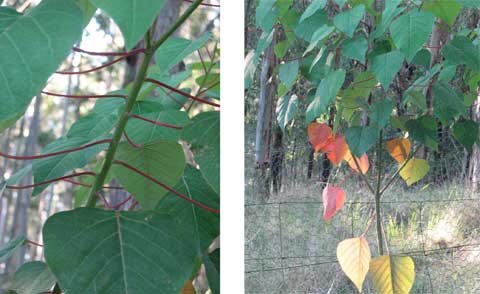 It’s Autumn, and my yard is being coloured– by more than autumn leaves.
It’s Autumn, and my yard is being coloured– by more than autumn leaves.
The indigenous Bleeding Heart Tree (Omalanthus populifolius) that I raised and planted shows how it got its name with its bright red veins that seem to drip to colour the lower leaves.
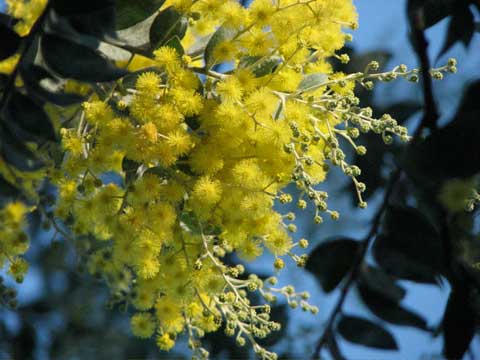 The first bunches of wattle blossom have burst out of their tightly fisted buds — small explosions of powdery gold, honey-scented. I grew lots of these from seeds that fell from a tree in my Aunty Mary’s front yard in Sydney; we didn’t know what sort it was, but perhaps it’s a Queensland Silver Wattle (Acacia podalyriifolia)?
The first bunches of wattle blossom have burst out of their tightly fisted buds — small explosions of powdery gold, honey-scented. I grew lots of these from seeds that fell from a tree in my Aunty Mary’s front yard in Sydney; we didn’t know what sort it was, but perhaps it’s a Queensland Silver Wattle (Acacia podalyriifolia)?
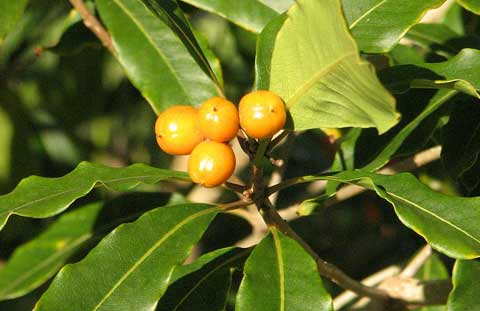 The bird-sown gift of a Pittosporum undulatum tree, also indigenous, has fruited its mini cumquat bunches for the first time. How did I miss the flowers? The bird didn’t plant it in the position I’d have chosen, but this has soared to such a height so quickly that it clearly found the perfect spot for the tree — if not for me!
The bird-sown gift of a Pittosporum undulatum tree, also indigenous, has fruited its mini cumquat bunches for the first time. How did I miss the flowers? The bird didn’t plant it in the position I’d have chosen, but this has soared to such a height so quickly that it clearly found the perfect spot for the tree — if not for me!
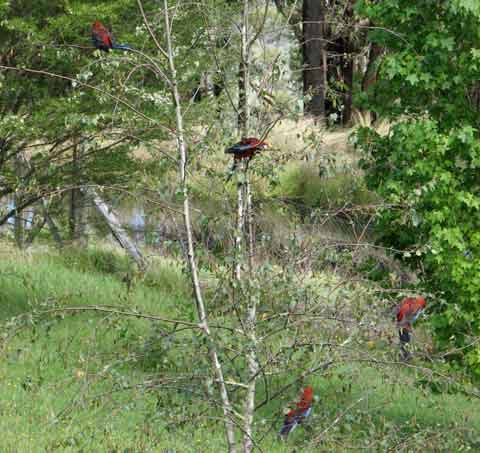 The birch tree may have had to wait for its Christmas decorations, but it was worth it. For a brief time four Crimson Rosellas bedecked its slender branches, the thin leaf cover hiding none of their brilliance.
The birch tree may have had to wait for its Christmas decorations, but it was worth it. For a brief time four Crimson Rosellas bedecked its slender branches, the thin leaf cover hiding none of their brilliance. A momentary adornment, as soon they were on the ground, sampling the seed heads of various grasses, waddling and poking about amongst the yellow flowers of the False Dandelion weeds. If I squinted, I could pretend I had a buttercup meadow.
A momentary adornment, as soon they were on the ground, sampling the seed heads of various grasses, waddling and poking about amongst the yellow flowers of the False Dandelion weeds. If I squinted, I could pretend I had a buttercup meadow.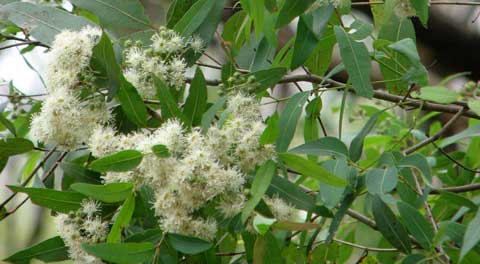 I don’t plant annuals, so my garden is never the riot of colour that others manage. I rely on bushes and bulbs to surprise me with blossoms.
I don’t plant annuals, so my garden is never the riot of colour that others manage. I rely on bushes and bulbs to surprise me with blossoms.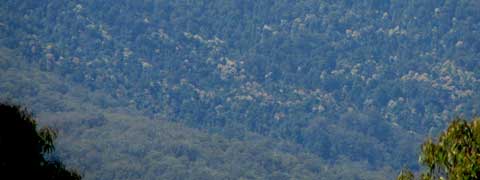 I am assuming this is what caused the splashes of cream I could see a week earlier, way off on the far slopes of the higher ridges opposite. Too far away for detail, even with binoculars.
I am assuming this is what caused the splashes of cream I could see a week earlier, way off on the far slopes of the higher ridges opposite. Too far away for detail, even with binoculars.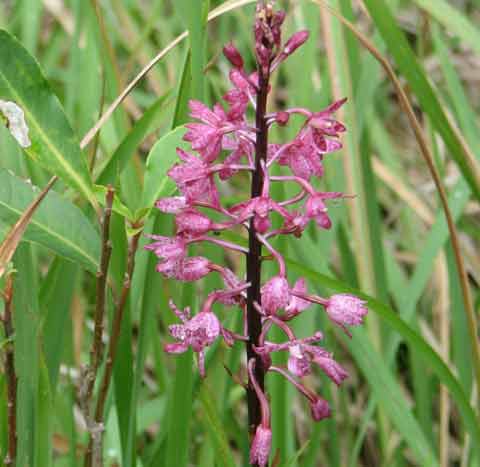 But in the immediate bush, I have no trouble spotting the highlights of summer wildflowers here, the Hyacinth Orchids, Dipodium punctatum. Apparently these orchids live on subterranean fungi which form on the decaying matter of the forest floor.
But in the immediate bush, I have no trouble spotting the highlights of summer wildflowers here, the Hyacinth Orchids, Dipodium punctatum. Apparently these orchids live on subterranean fungi which form on the decaying matter of the forest floor.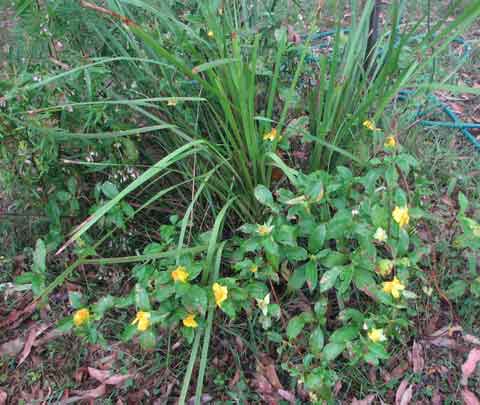 Without the need to sow or prune or feed, native plants appear, thrive and flower on my yard, where and as they choose.
Without the need to sow or prune or feed, native plants appear, thrive and flower on my yard, where and as they choose.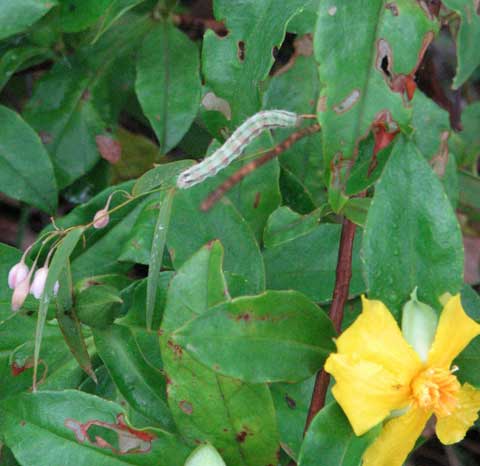 On looking closer at this little pocket of my self-sown garden, I saw it had an inhabitant – a green and pink and hairy caterpillar, which I cannot identify.
On looking closer at this little pocket of my self-sown garden, I saw it had an inhabitant – a green and pink and hairy caterpillar, which I cannot identify. The spectacular flower spikes of my King Orchids are long devoid of their blossoms, studded with only the tiny gold memories of where they were once attached.
The spectacular flower spikes of my King Orchids are long devoid of their blossoms, studded with only the tiny gold memories of where they were once attached.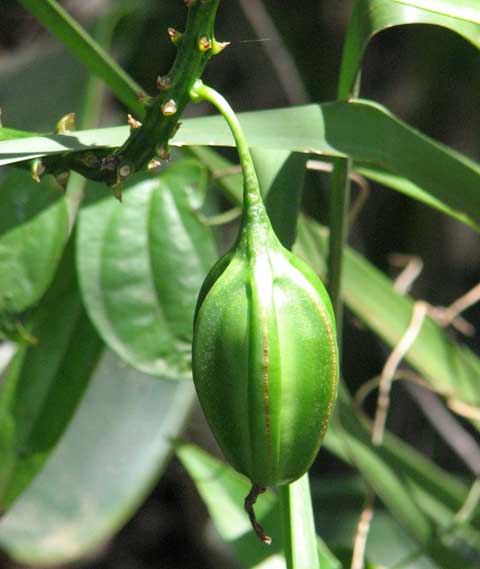 Up close they are elegantly sculpted, puffed and blown up like gooseberry paper cases, but no delicacy there; firm and fleshy, with a gold stripe down each rib, smart as the Tin Soldier’s trousers.
Up close they are elegantly sculpted, puffed and blown up like gooseberry paper cases, but no delicacy there; firm and fleshy, with a gold stripe down each rib, smart as the Tin Soldier’s trousers.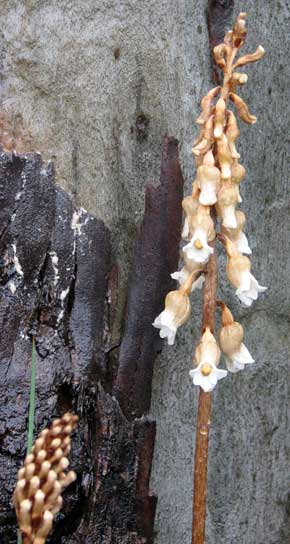 The forest here never ceases to surprise me with the apparently infinite number of plants or fungi that I have never seen before.
The forest here never ceases to surprise me with the apparently infinite number of plants or fungi that I have never seen before.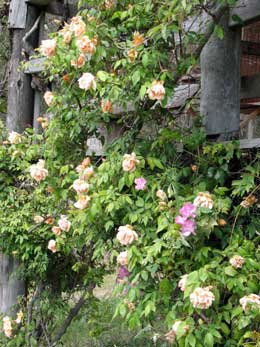 The cycle of boss tenants around here changes so often I hardly have time to adjust.
The cycle of boss tenants around here changes so often I hardly have time to adjust. 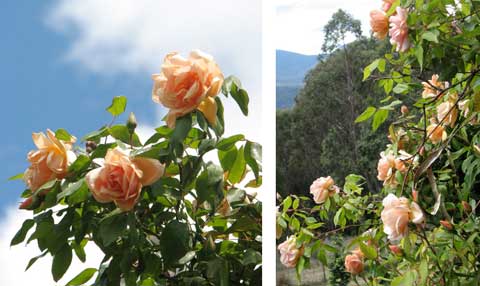
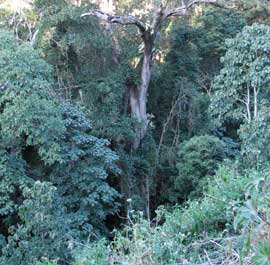 Drivng back from the Gloucester district a few weeks ago, I passed above the very steep and narrow, very special gully near Dungog where a remnant rainforest of giant trees like figs and stinging trees and white cedars stand tall and proud amidst a dense jungle of vines competing for the light.
Drivng back from the Gloucester district a few weeks ago, I passed above the very steep and narrow, very special gully near Dungog where a remnant rainforest of giant trees like figs and stinging trees and white cedars stand tall and proud amidst a dense jungle of vines competing for the light.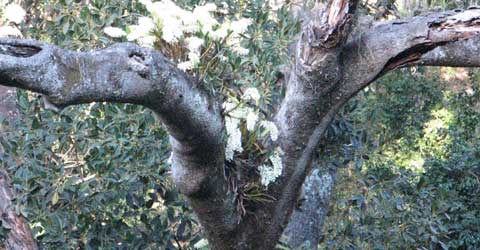 Thanks to the magic of my zoom lens, I could be sure that they were King Orchids (Dendrobium speciosum, var. hillii) Hundreds of feet up, several fat clumps of them had colonised in forks of the trunk, clinging on with their fleshy fingers as they climbed along the broad branches. A staghorn shared their treehouse.
Thanks to the magic of my zoom lens, I could be sure that they were King Orchids (Dendrobium speciosum, var. hillii) Hundreds of feet up, several fat clumps of them had colonised in forks of the trunk, clinging on with their fleshy fingers as they climbed along the broad branches. A staghorn shared their treehouse.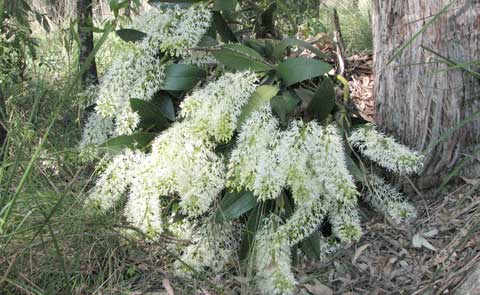 At the time, my orphaned clumps of the same orchid had been still in bud, my place being so much higher in altitude.
At the time, my orphaned clumps of the same orchid had been still in bud, my place being so much higher in altitude.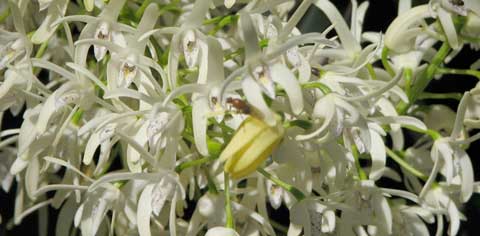
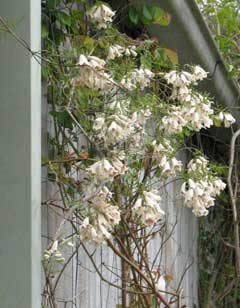 My shed is made from rusty but sound old corrugated iron, with no charm in shape or design to allow me to call it ‘rustic’. So it has to be disguised.
My shed is made from rusty but sound old corrugated iron, with no charm in shape or design to allow me to call it ‘rustic’. So it has to be disguised.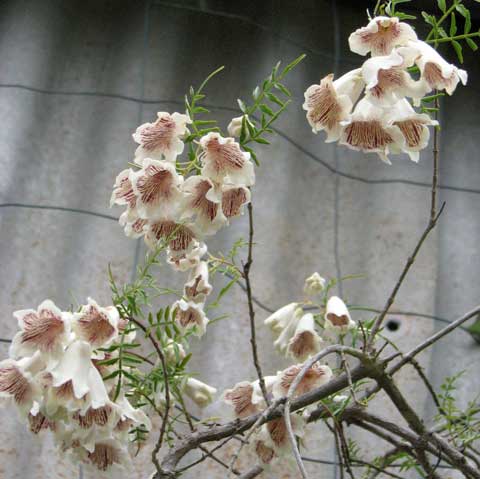 It never has much in the way of foliage and what it has is very fine, but now it has burst into a mass of clustered blossom bells, flaunting their frilly cream skirts and showing off their maroon streaked undersides.
It never has much in the way of foliage and what it has is very fine, but now it has burst into a mass of clustered blossom bells, flaunting their frilly cream skirts and showing off their maroon streaked undersides.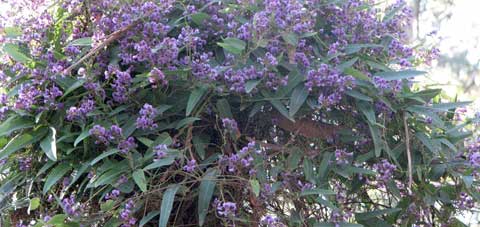 It’s spring! In the bush, dead spars of tree trunks have sprouted flamboyant purple head-dresses as Hardenbergia stems have reached the top and found the light.
It’s spring! In the bush, dead spars of tree trunks have sprouted flamboyant purple head-dresses as Hardenbergia stems have reached the top and found the light.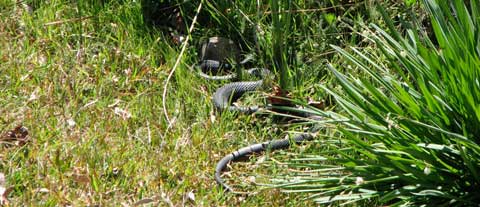 In the garden the winter bulbs aren’t even finished, the spring ones haven’t started; there are many clumps of green strappy leaves gathering food for the bulbs for next year—so I can’t mow these areas yet.
In the garden the winter bulbs aren’t even finished, the spring ones haven’t started; there are many clumps of green strappy leaves gathering food for the bulbs for next year—so I can’t mow these areas yet.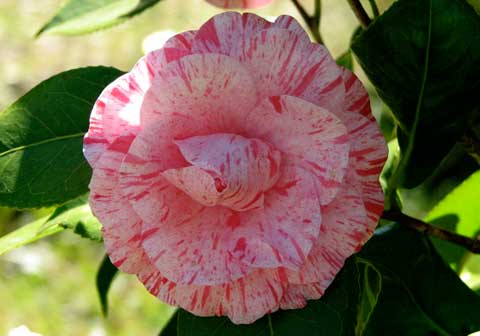 Just spring, and another of my old-fashioned camellia bushes has come into bloom. Grown from cuttings taken from the garden of an old house in Port Macquarie, this one is lolly pink, streaked with strawberry. A candy camellia. Ain’t she sweet?
Just spring, and another of my old-fashioned camellia bushes has come into bloom. Grown from cuttings taken from the garden of an old house in Port Macquarie, this one is lolly pink, streaked with strawberry. A candy camellia. Ain’t she sweet?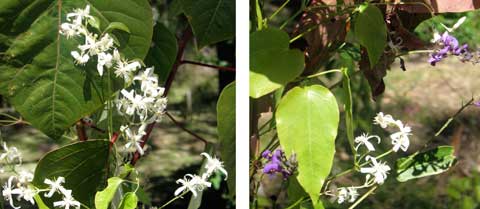 In a less domesticated part of my yard, three native plants have formed a dainty trio. A young Omalanthus tree, often called the Bleeding Heart Tree, only as tall as myself, has been wreathed in thin vines: the clinging bridal shower of Clematis aristata, Traveller’s Joy, and the purple pea highlights of Hardenbergia, Native Sarsparilla. The tree I propagated and planted, the vines are surprise gifts of nature.
In a less domesticated part of my yard, three native plants have formed a dainty trio. A young Omalanthus tree, often called the Bleeding Heart Tree, only as tall as myself, has been wreathed in thin vines: the clinging bridal shower of Clematis aristata, Traveller’s Joy, and the purple pea highlights of Hardenbergia, Native Sarsparilla. The tree I propagated and planted, the vines are surprise gifts of nature.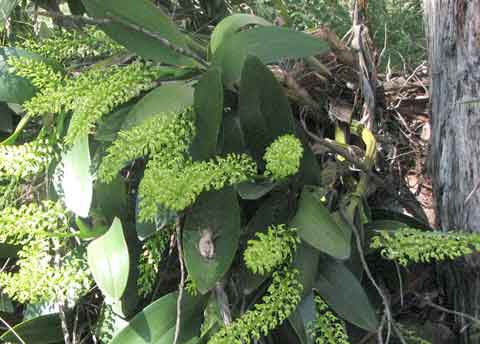 Found in my rainforest gully years ago, the increasing weight of this clump had probably caused the casuarina branch on which it had grown to come crashing down. I relocated it to rocks at the base of a stringybark in my yard, where it has fleshily multiplied since.
Found in my rainforest gully years ago, the increasing weight of this clump had probably caused the casuarina branch on which it had grown to come crashing down. I relocated it to rocks at the base of a stringybark in my yard, where it has fleshily multiplied since.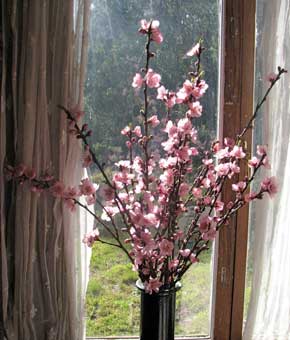 I have now managed to prune four of my fruit trees so as to be able to net them later. It has to be gradual, as my thumb joints don’t like too much secateur work at a time.
I have now managed to prune four of my fruit trees so as to be able to net them later. It has to be gradual, as my thumb joints don’t like too much secateur work at a time.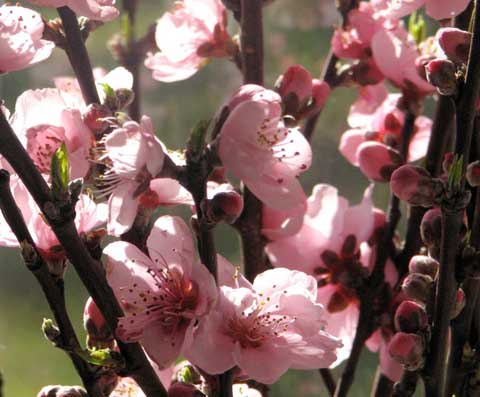 Now, one week later, Spring has come to my cabin interior as those buds have burst into fragile pink blooms with spangles of stamens and even an occasional bright green leaf unfolding.
Now, one week later, Spring has come to my cabin interior as those buds have burst into fragile pink blooms with spangles of stamens and even an occasional bright green leaf unfolding.